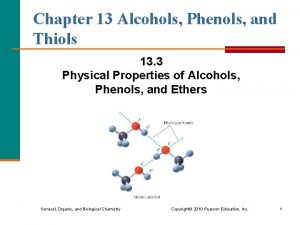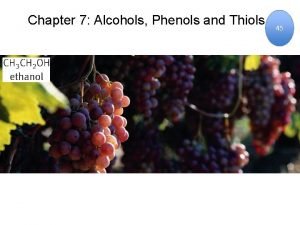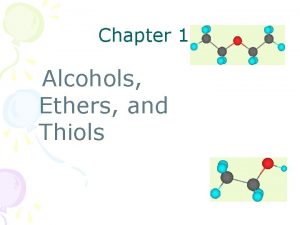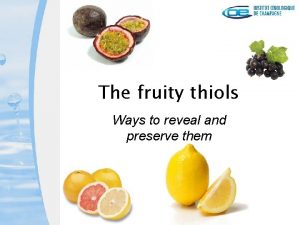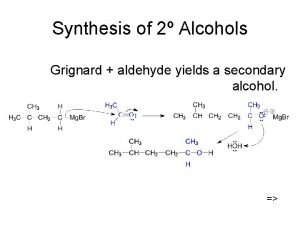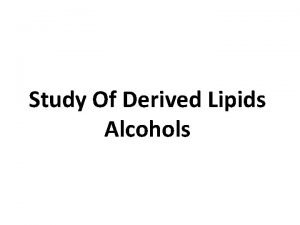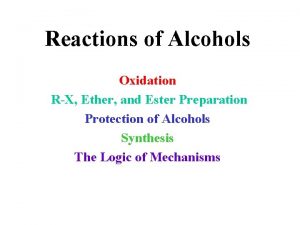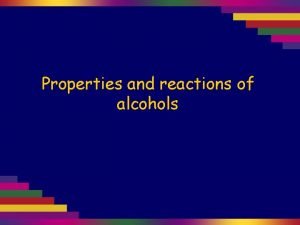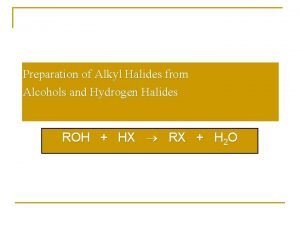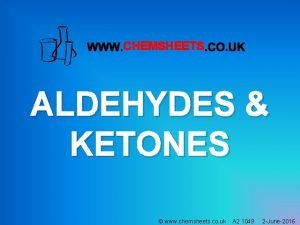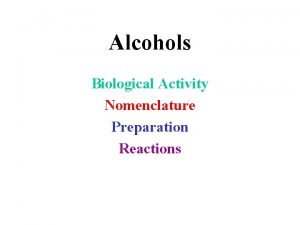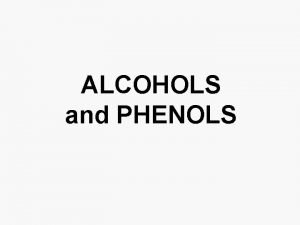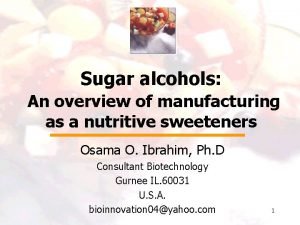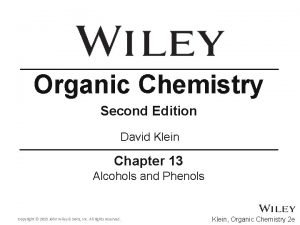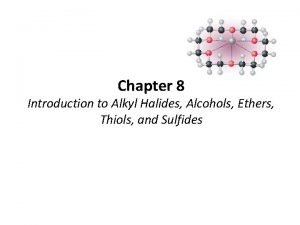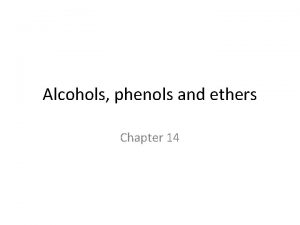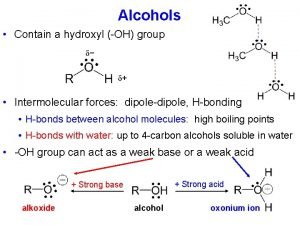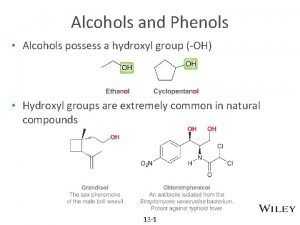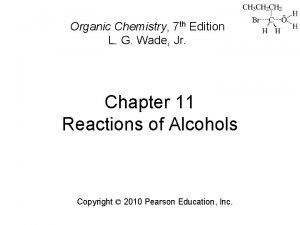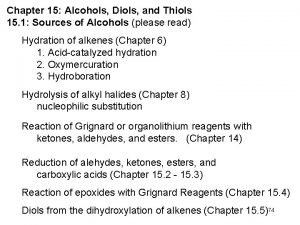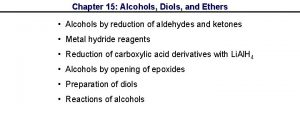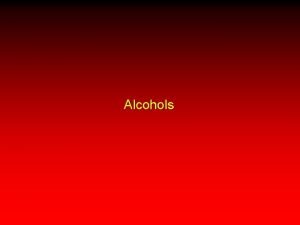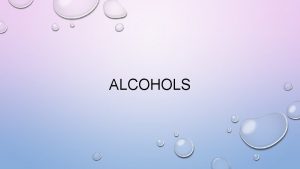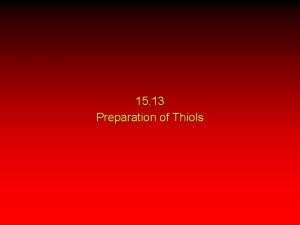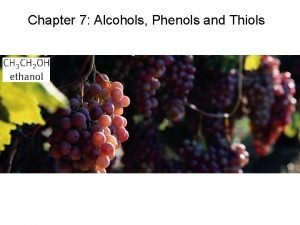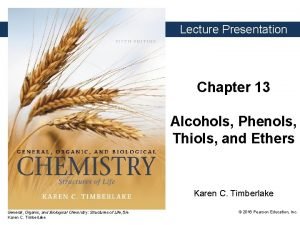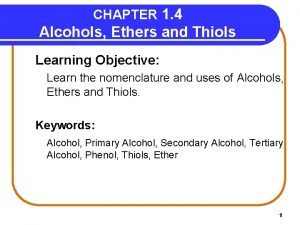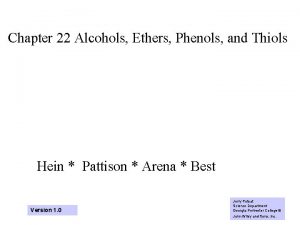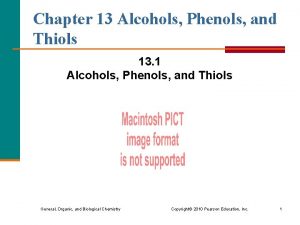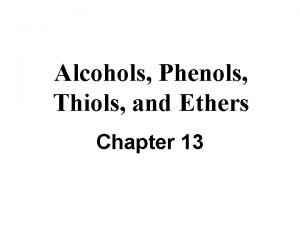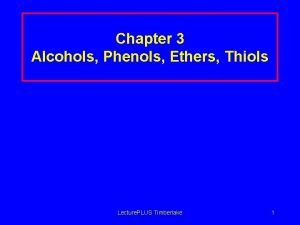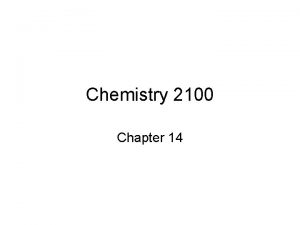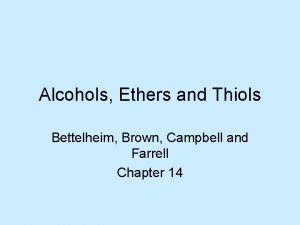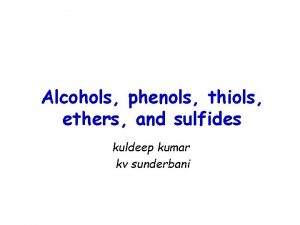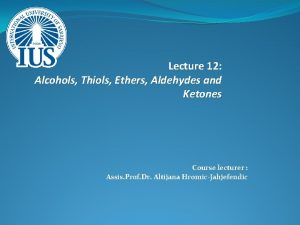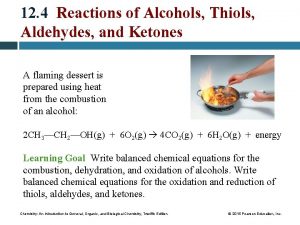Chapter 15 Alcohols Diols and Thiols Copyright The

























































- Slides: 57

Chapter 15 Alcohols, Diols, and Thiols Copyright © The Mc. Graw-Hill Companies, Inc. Permission required for reproduction or display.

Sources of Alcohols

Sources of Alcohols Reactions discussed in earlier chapters (Table 15. 1) Hydration of alkenes Hydroboration-oxidation of alkenes Hydrolysis of alkyl halides Syntheses using Grignard reagents Organolithium reagents

Sources of Alcohols New methods in Chapter 15 Reduction of aldehydes and ketones Reduction of carboxylic acids Reaction of Grignard reagents with epoxides Diols by hydroxylation of alkenes

Preparation of Alcohols by Reduction of Aldehydes and Ketones

Reduction of Aldehydes Gives Primary Alcohols R R C H O H C H OH

Example: Catalytic Hydrogenation O CH 3 O CH + H 2 Pt, ethanol CH 3 O CH 2 OH (92%)

Reduction of Ketones Gives Secondary Alcohols R R C R' O H C R' OH

Example: Catalytic Hydrogenation H O + H 2 OH Pt ethanol (93 -95%)

Retrosynthetic Analysis R H C R OH H: – R C R' O C O H H H C R OH H: – R'

Metal Hydride Reducing Agents H H + Na H – B H Li + Al H H H Sodium borohydride H – Lithium aluminum hydride act as hydride donors

Examples: Sodium Borohydride Aldehyde O 2 N O O 2 N Na. BH 4 CH 2 OH CH methanol (82%) Ketone O Na. BH 4 ethanol H OH (84%)

Lithium Aluminum Hydride More reactive than sodium borohydride. Cannot use water, ethanol, methanol etc. as solvents. Diethyl ether is most commonly used solvent.

Examples: Lithium Aluminum Hydride Aldehyde O CH 3(CH 2)5 CH 1. Li. Al. H 4 diethyl ether 2. H 2 O CH 3(CH 2)5 CH 2 OH (86%) Ketone O (C 6 H 5)2 CHCCH 3 1. Li. Al. H 4 diethyl ether 2. H 2 O OH (C 6 H 5)2 CHCHCH 3 (84%)

Selectivity Neither Na. BH 4 or Li. Al. H 4 reduces carbon-carbon double bonds. O 1. Li. Al. H 4 diethyl ether 2. H 2 O (90%) H OH

Preparation of Alcohols By Reduction of Carboxylic Acids

Reduction of Carboxylic Acids Gives Primary Alcohols R R C HO O H C H lithium aluminum hydride is only effective reducing agent OH

Example: Reduction of a Carboxylic Acid O 1. Li. Al. H 4 diethyl ether COH 2. H 2 O CH 2 OH (78%)

Preparation of Alcohols From Epoxides

Reaction of Grignard Reagents with Epoxides R Mg. X CH 2 H 2 C O R CH 2 OMg. X H 3 O + RCH 2 OH

Example CH 2 CH 3(CH 2)4 CH 2 Mg. Br + H 2 C O 1. diethyl ether 2. H 3 O+ CH 3(CH 2)4 CH 2 CH 2 OH (71%)

Preparation of Diols

Diols are Prepared by. . . Reactions used to prepare alcohols Hydroxylation of alkenes

Example: Reduction of a Dialdehyde O O HCCH 2 CH CH 3 H 2 (100 atm) Ni, 125°C HOCH 2 CHCH 2 OH CH 3 3 -Methyl-1, 5 -pentanediol (81 -83%)

Hydroxylation of Alkenes Gives Vicinal Diols Vicinal diols have hydroxyl groups on adjacent carbons. Ethylene glycol (HOCH 2 OH) is most familiar example.

Osmium Tetraoxide is Key Reagent C C C HO C Os. O 4 C O O Os O O Cyclic osmate ester C OH

Example CH 3(CH 2)7 CH CH 2 (CH 3)3 COOH Os. O 4 (cat) tert-Butyl alcohol HO– CH 3(CH 2)7 CHCH 2 OH OH (73%)

Example Stereospecific syn addition of —OH groups to each carbon of double bond H (CH 3)3 COOH Os. O 4 (cat) H tert-Butyl alcohol HO– H H HO (62%) OH

Reactions of Alcohols: A Review and a Preview Copyright © The Mc. Graw-Hill Companies, Inc. Permission required for reproduction or display.

Table 15. 2 Review of Reactions of Alcohols Reaction with hydrogen halides Reaction with thionyl chloride Reaction with phosphorous trihalides Acid-catalyzed dehydration Conversion to p-toluenesulfonate esters

New Reactions of Alcohols in This Chapter Conversion to ethers Esterification Oxidation Cleavage of vicinal diols

Conversion of Alcohols to Ethers

Conversion of Alcohols to Ethers RCH 2 O CH 2 R H OH H+ RCH 2 O CH 2 R + H OH Acid-catalyzed Referred to as a "condensation" Equilibrium; most favorable for primary alcohols

Example 2 CH 3 CH 2 CH 2 OH H 2 SO 4, 130°C CH 3 CH 2 CH 2 OCH 2 CH 2 CH 3 (60%)

Mechanism of Formation of Diethyl Ether Step 1: • • CH 3 CH 2 O • • H OSO 2 OH H + CH 3 CH 2 O • • H + H – OSO 2 OH

Mechanism of Formation of Diethyl Ether Step 2: H CH 3 CH 2 +O • • H CH 3 CH 2 + CH 3 CH 2 O • • H + • • O • • H H • • H

Mechanism of Formation of Diethyl Ether Step 3: CH 3 CH 2 + CH 3 CH 2 O • • + • • H H • • OCH CH 2 3 H +

Intramolecular Analogue HOCH 2 CH 2 CH 2 OH H 2 SO 4 via: 130° • • O O (76%) H Reaction normally works well only for 5 - and 6 -membered rings. H O • • + H

Esterification

Esterification O ROH + O H+ R'COR + R'COH condensation Fischer esterification acid catalyzed reversible H 2 O

Example of Fischer Esterification O COH + CH 3 OH 0. 1 mol 0. 6 mol H 2 SO 4 O COCH 3 + H 2 O 70% yield based on benzoic acid

Reaction of Alcohols with Acyl Chlorides O ROH + R'CCl O R'COR + High yields Not reversible when carried out in presence of pyridine. HCl

Example CH 3 CH 2 O OH + O 2 N CCl CH 3 pyridine CH 3 CH 2 O NO 2 OC CH 3 (63%)

Reaction of Alcohols with Acid Anhydrides O O ROH + R'COCR' O R'COR + O R'COH analogous to reaction with acyl chlorides

Example O O C 6 H 5 CH 2 OH + F 3 CCOCCF 3 pyridine O C 6 H 5 CH 2 OCCF 3 (83%)

Oxidation of Alcohols

Oxidation of Alcohols Primary alcohols RCH 2 OH O O RCH RCOH Secondary alcohols OH O RCHR' RCR' from H 2 O

Typical Oxidizing Agents Aqueous solution Mn(VII) Cr(VI) KMn. O 4 H 2 Cr 2 O 7

Aqueous Cr(VI) H FCH 2 CH 2 OH K 2 Cr 2 O 7 OH H 2 SO 4 H 2 O Na 2 Cr 2 O 7 H 2 SO 4 H 2 O O O FCH 2 CH 2 COH (74%) (85%)

H Mechanism • • O H • • H C O HOCr. OH OH O C O Cr. OH O Involves formation and elimination of a chromate ester. C O

Nonaqueous Sources of Cr(VI) All are used in CH 2 Cl 2 Pyridinium dichromate (PDC) (C 5 H 5 NH+)2 Cr 2 O 72– Pyridinium chlorochromate (PCC) C 5 H 5 NH+ Cl. Cr. O 3–

Example: Oxidation of a Primary Alcohol with PCC Cl. Cr. O 3– +N H CH 3(CH 2)5 CH 2 OH PCC CH 2 Cl 2 O CH 3(CH 2)5 CH (78%)

Example: Oxidation of a Primary Alcohol with PDC (CH 3)3 C CH 2 OH PDC CH 2 Cl 2 O (CH 3)3 C CH (94%)

Oxidative Cleavage of Vicinal Diols

Cleavage of Vicinal Diols by Periodic Acid C HO HIO 4 C OH C O + O C

Cleavage of Vicinal Diols by Periodic Acid CH 3 CH HO CCH 3 OH HIO 4 O CH (83%) O + CH 3 CCH 3

Cyclic Diols are Cleaved OH HIO 4 O O HCCH 2 CH 2 CH OH
 Alcohols phenols thiols and ethers
Alcohols phenols thiols and ethers Thiol molecules
Thiol molecules Upac
Upac Acidity of thiols
Acidity of thiols Ioc revelation thiols
Ioc revelation thiols Tertiary alcohol oxidation
Tertiary alcohol oxidation Synthesis of tertiary alcohols
Synthesis of tertiary alcohols Cppp cholesterol
Cppp cholesterol High boiling point alcohols
High boiling point alcohols Oxidation of alcohol mechanism
Oxidation of alcohol mechanism Lucas test
Lucas test Preparation of alkyl halides from alcohols
Preparation of alkyl halides from alcohols Chemsheets reactions of alcohols 1 answers
Chemsheets reactions of alcohols 1 answers Tscl py reaction
Tscl py reaction Sp
Sp Sugar alcohol names
Sugar alcohol names Alcohols nomenclature
Alcohols nomenclature Alcohols nomenclature
Alcohols nomenclature Alcohols nomenclature
Alcohols nomenclature Isopropyl methyl ether
Isopropyl methyl ether What does pcc ch2cl2 do
What does pcc ch2cl2 do Lucas reagent test
Lucas reagent test Hình ảnh bộ gõ cơ thể búng tay
Hình ảnh bộ gõ cơ thể búng tay Bổ thể
Bổ thể Tỉ lệ cơ thể trẻ em
Tỉ lệ cơ thể trẻ em Chó sói
Chó sói Tư thế worm breton là gì
Tư thế worm breton là gì Chúa yêu trần thế
Chúa yêu trần thế Các môn thể thao bắt đầu bằng từ đua
Các môn thể thao bắt đầu bằng từ đua Thế nào là hệ số cao nhất
Thế nào là hệ số cao nhất Các châu lục và đại dương trên thế giới
Các châu lục và đại dương trên thế giới Công của trọng lực
Công của trọng lực Trời xanh đây là của chúng ta thể thơ
Trời xanh đây là của chúng ta thể thơ Mật thư anh em như thể tay chân
Mật thư anh em như thể tay chân Làm thế nào để 102-1=99
Làm thế nào để 102-1=99 Phản ứng thế ankan
Phản ứng thế ankan Các châu lục và đại dương trên thế giới
Các châu lục và đại dương trên thế giới Thể thơ truyền thống
Thể thơ truyền thống Quá trình desamine hóa có thể tạo ra
Quá trình desamine hóa có thể tạo ra Một số thể thơ truyền thống
Một số thể thơ truyền thống Cái miệng bé xinh thế chỉ nói điều hay thôi
Cái miệng bé xinh thế chỉ nói điều hay thôi Vẽ hình chiếu vuông góc của vật thể sau
Vẽ hình chiếu vuông góc của vật thể sau Thế nào là sự mỏi cơ
Thế nào là sự mỏi cơ đặc điểm cơ thể của người tối cổ
đặc điểm cơ thể của người tối cổ V cc cc
V cc cc Vẽ hình chiếu đứng bằng cạnh của vật thể
Vẽ hình chiếu đứng bằng cạnh của vật thể Phối cảnh
Phối cảnh Thẻ vin
Thẻ vin đại từ thay thế
đại từ thay thế điện thế nghỉ
điện thế nghỉ Tư thế ngồi viết
Tư thế ngồi viết Diễn thế sinh thái là
Diễn thế sinh thái là Dot
Dot Số.nguyên tố
Số.nguyên tố Tư thế ngồi viết
Tư thế ngồi viết Lời thề hippocrates
Lời thề hippocrates Thiếu nhi thế giới liên hoan
Thiếu nhi thế giới liên hoan
